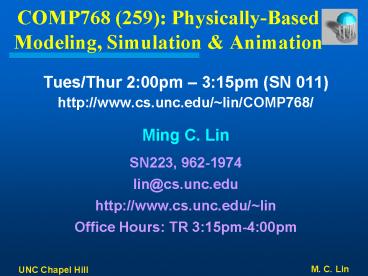COMP768 (259): Physically-Based Modeling, Simulation - PowerPoint PPT Presentation
Title:
COMP768 (259): Physically-Based Modeling, Simulation
Description:
Office Hours: TR 3:15pm-4:00pm. UNC Chapel Hill. M. C. Lin. Prerequisities ... Be aware with a collection of geometric algorithms for modeling contacts. ... – PowerPoint PPT presentation
Number of Views:112
Avg rating:3.0/5.0
Title: COMP768 (259): Physically-Based Modeling, Simulation
1
COMP768 (259) Physically-Based Modeling,
Simulation Animation
- Tues/Thur 200pm 315pm (SN 011)
- http//www.cs.unc.edu/lin/COMP768/
- Ming C. Lin
- SN223, 962-1974
- lin_at_cs.unc.edu
- http//www.cs.unc.edu/lin
- Office Hours TR 315pm-400pm
2
Prerequisities
- COMP 662 (250) - Scientific Computing II
- or
- Math 661 (191) - Scientific Computing I
- COMP 665 (235) - Images, Graphics Vision or
- COMP 575 (136) - Elementary 3D Graphics
3
Textbook References
- SIGGRAPH course notes
- In-class handouts
- Other research papers
- More references (books, papers, pointers to other
interesting resources) available at the course
website
4
Course Overview
- 3D Models Images -gt Rendering
- (COMP 770/236 870/238)
- Virtual Reality Interface (COMP 872/239)
- Geometric Solid Modeling (COMP 767/258)
- This course focuses on
- MOVEMENTS making them move !
5
What Will We Be Doing
- Geometry
- Collision Detection
- Computing Contact Manifolds
- Mechanics
- Particle Dynamics
- Rigid Body Dynamics
- Non-Rigid Body Dynamics
- Fluid Dynamics
- Numerical Computing
- Initial Value Problems
- Boundary Value Problems
- Constraints Differential-Algebraic Equations
6
Possible Applications
- Computer Animation
- Virtual Environments
- Rapid Prototyping
- Haptic Rendering
- Computer Game Dynamics
- Robotics and Automation
- Medical Simulation and Analysis
7
Goals
- Be aware with a collection of geometric
algorithms for modeling contacts. - Be knowledgeable with the following numerical
methods for simulation initial value problems,
constrained optimization, differential-algebraic
equations, boundary value problems, etc - Be familiar with the following modeling paradigms
of physical and biological systems particle
dynamics, rigid body dynamics, flexible and
deformable bodies - Be able to analyze the correctness and runtime
performance of a given simulation method. - Be able to apply some techniques to research
problems.
8
See Course Website
- http//www.cs.unc.edu/lin/COMP768-S09
- for more details































